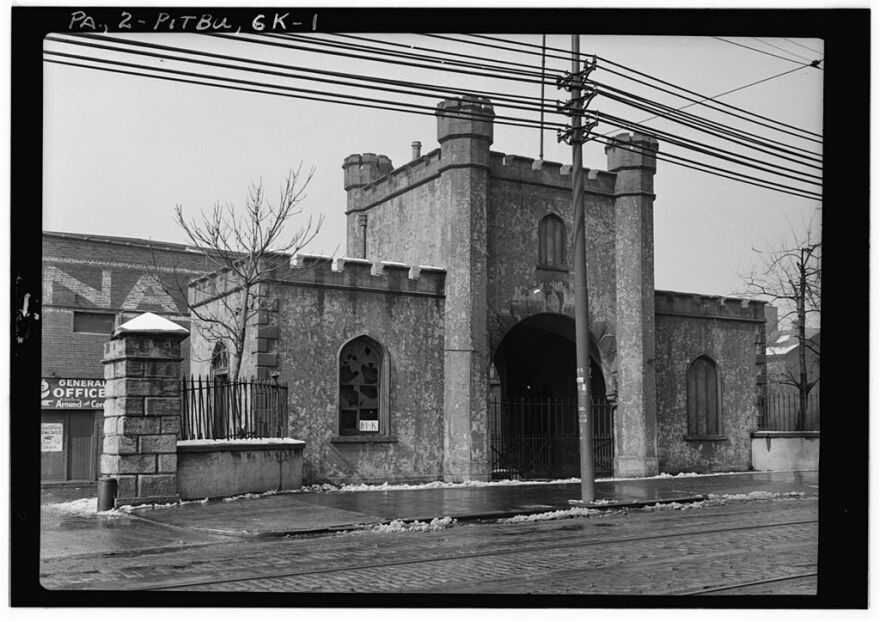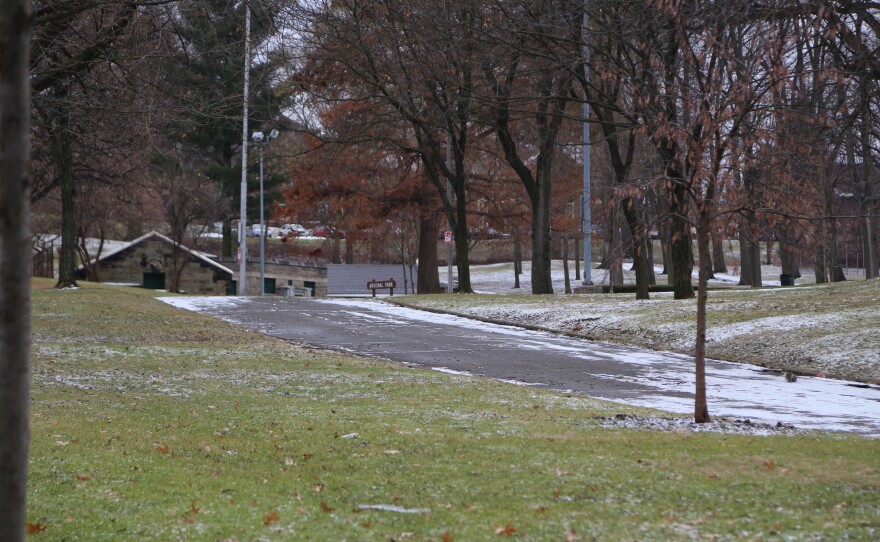*UPDATED
Cars rumble overhead as historian John Schalcosky trudges through crunching snow beneath the 40th Street Bridge in Lawrenceville. Gesturing toward the Allegheny River bank, he flicks on his iPhone flashlight.
“Where we’re walking now is the location of closed up tunnels,” said Schalcosky, who runs the Odd, Mysterious and Fascinating History of Pittsburgh Facebook page. “That's clearly another room. But there's no way to get up to it unless we climb up and peek in."
He points to a grated, door-sized opening about five feet up a colorful, graffiti-covered wall. Inside, there’s a descending staircase.

Schalcosky has the bridge's blueprints to prove it.
“It’s here, [but] why? There’s no point or purpose unless you were trying to leave some sort of access to history,” he said. “Which is, from all accounts, what we have here.”
He’s talking about a long tunnel rumored to run from the river to the old Allegheny Arsenal. It’s the same story Good Question listener and Lawrenceville resident Heather Mallak heard last year during an Arsenal history event in the park.
“Based on some of the knowledge I had of what they were doing in the arsenal here, it seemed to make sense that there were tunnels that connected to the river,” she said. “I was always curious to have it investigated deeper, what that connection was and if they’re accessible still.”
The Allegheny Arsenal was a crucial ammunition manufacturing and supply location during the Civil War. It was also the site of the worst civilian causality of the conflict when an accidental explosion killed 78 workers in 1862.

It spanned about 30 acres of land in Lawrenceville and its positioning along the three rivers made it a strategic location.
“This was the arsenal of the Union,” Schalcosky said. “The Mason-Dixon line was only 70 miles away.”
The former military asset became folklore for modern day neighborhood kids. Lawrenceville native Joe Colella remembers hearing about the tunnels as a child and eagerly waiting to confirm the rumor on his own.
“We were too young to go down there at first, so we had to wait years until we were allowed to go off the blocks,” he said.
Finally, in the 1970s, he said he and his buddies walked the railroad tracks to central Lawrenceville, which people then referred to as the 9th Ward, and hopped a fence near the bridge.

“We had to move some pallets and lo-and-behold there was a piece of a door there, partially uncovered,” Colella said. “We crawled in and [there was only about a foot] they didn’t backfill with dirt.”
Colella said even with their flashlights, they weren’t able to see much of the tunnel’s interior, but he did remember seeing small doors staggered up and down the corridor.

“We had always heard rumors that there were cannons and cannonballs in there,” Colella said. “I guess someone really did the rumor up, because all we found was dirt and empty cans.”
But Tom Powers and Jim Wudarczyk with the Lawrenceville Historical Society said Colella and his pals' exploration likely wasn’t in the rumored underground tunnels.
“Many people swear that they were in Arsenal tunnels, when in fact they were in the sub-structure of the 40th Street Bridge,” they wrote in an email.
Several years ago, the LHS took a trip under the neighborhood to find out for themselves. They found that there was a passageway, but it was less like a tunnel and more like a series of small rooms. Jude Wudarczyk wrote in a 2002 issue of LHS newsletter that a variety of construction materials were used in each chamber.
“One of the most interesting finds within the chambers is a narrow passage....made visible because one of the floors gave way,” Wudarczyk wrote. “The passage might have been a hallway or a sewer from the Allegheny Arsenal.”
My @905wesa #goodquestion re:Arsenal interviewed @PPSnews Principal Camper, researcher by reporter Katie Blackley @HistoryCenter Edu info! pic.twitter.com/NtLubZVpbV
— Heather Mallak (@digisalad) January 25, 2018
Mallak heard the tunnels ran under, or through, Arsenal Middle School. Principal Patti Camper, who's worked there 14 years, said that’s not the case.
“When I became principal, I wanted to know where they were," she said. "I went in search of the tunnels, only to find out they didn’t exist.”

According to Schalcosky, the tunnels would have followed the path of 40th Street, meaning they’d likely miss the school. But LHS said that might not be accurate, because the placement of the streets has changed since the 19th century.
Plus, as Camper pointed out, the weight of the school would have likely crushed any remaining tunnels.
“I wish they did [connect to the school],” Camper said. “I think it’d be super cool. But they don’t connect, and we don’t have any access to them.”
Built on the grounds of the old war depository in 1931, Arsenal Middle School has a number of items dedicated to remembering the site’s history. Near the entrance, there’s a plaque honoring the victims of the 1862 explosion, with a winged angel at the center. Outside the building in the nearby park, a Rodman cannon stands as another tribute to the dead.
“Our historical status is really connected to the Allegheny Arsenal, just not to the tunnels,” Camper said.
The Travel Channel’s Off Limits: Pittsburgh recently looked into the tunnels, too. But LHS said the findings on the show confirmed that the underground passageways were likely used for sewage or water transportation during the Civil War.

This is part of our Good Question! series where we investigate what you've always wondered about Pittsburgh, its people and its culture.
*This story was updated at 4:08 p.m. on Tuesday, Feb. 13, 2018 to include more historical information on the tunnels.









